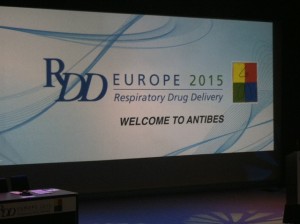Due to the long lead time required to plan the conference, the organizers booked the meeting location before the Palais des Congrès, which opened in late 2013, was even built. At the time, the building plans included eleven small meeting rooms, one less than RDD Europe needed for the workshops which have been a signature feature of the conference since its beginning. Knowing that RDD Europe would need twelve rooms, the architects reconfigured the design to accommodate the meeting.
The workshops remained a popular feature at RDD Europe 2015, with a workshop presented by AstraZeneca titled “Predicting the Fate of Inhaled Molecules and Applying this Knowledge during Development” and a workshop titled “Evolving Regulatory Requirements for pMDI Registrations in the US” presented by 3M Drug Delivery Systems filling up in advance of the meeting.
Other workshops covered topics such as “Demonstrating the Value of Regional Imaging Biomarkers in Respiratory Drug Development through Functional Respiratory Imaging (FRI)” (FluidDA), “Assessing Aggregate Performance and the Presence of Foreign Particulate in OINDP’s” (Gateway Analytical), and “Application of New Testing Technologies and Methods to Determine Critical Quality Attributes of pMDIs” (Proveris Scientific).
This year’s scientific program began with a plenary lecture delivered by Professor Bruce Rubin, Chair of the Department of Pediatrics at Virginia Commonwealth University. In his talk, titled “Aerosol Therapy for Children: Unhelpful Myths and Future Directions,” Dr. Rubin presented a series of mistaken assumptions about pediatric asthma treatment which he says are endemic among clinicians.
Among the myths he cited were ingrained beliefs that aerosol therapy works best if the child is crying, that administration of inhaled medications to children during sleep is effective, and that jet nebulizers are more effective than MDIs.
Chief among these myths, he said, is the notion that health care providers can recognize non-adherent patients when in reality clinicians often fail to recognize that a patient with treatment resistant asthma is actually “inhaler resistant.” Dr. Rubin appealed to device developers for new delivery technology to improve adherence.



